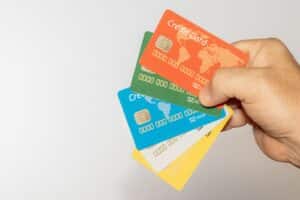How to Manage Multiple Credit Cards Effectively

Anúncios
One of the major benefits of holding multiple credit cards is the ability to diversify and maximize rewards. Different credit cards offer various rewards programs, such as cash back, travel miles, or points that can be redeemed for a variety of goods or services. By strategically using the right card for each purchase, you can earn maximum rewards on every dollar spent.
For example, a card that offers extra rewards for grocery shopping can be used exclusively for those purchases, while a different card might give higher rewards on dining out or travel. Diversifying rewards programs not only maximizes the benefits but also helps you accumulate points or cash back faster.
Improving Credit Score
Another significant advantage is the potential improvement in your credit score. This is primarily due to the increase in your total available credit limit. When you have multiple credit cards, the combined credit limits can boost your overall available credit. As long as you maintain low balances on each card, your credit utilization rate will decrease. Credit utilization rate is a key factor in credit scoring models and should ideally be below 30%. Therefore, multiple cards with low balances can positively impact your credit score over time.
Anúncios
Backup Payment Option
Having multiple credit cards also provides a valuable backup payment option. Imagine your primary card is lost, stolen, or simply experiencing a technical issue. In such cases, having an alternative card can save you from being stuck without a payment method.
This is particularly important in emergencies, during travel, or when making essential purchases. It’s always a good idea to keep a secondary credit card in a secure place so that you’re prepared for any unexpected situations.
Transitioning from understanding the benefits of having multiple credit cards, the next step is to explore how you can effectively manage multiple payment systems to avoid pitfalls and enjoy the advantages. Keeping track of multiple cards can seem challenging, but with strategic organization, it can become a straightforward part of your financial routine.
Anúncios
Organizing Payment Systems
When managing multiple credit cards, organizing payment systems effectively is critical to staying on top of due dates and avoiding costly late fees. By setting up digital calendar reminders, implementing automatic payments, and creating a tracking spreadsheet, you can ensure that your finances remain well-ordered.
Setting Up Digital Calendar Reminders for Different Due Dates
One of the easiest ways to keep track of multiple credit card payments is by using digital calendar reminders. Add each card’s due date to your calendar app, setting the reminder a few days before the actual due date. This proactive step gives you sufficient time to make payments even if plans change unexpectedly. Additionally, use color coding for each card to visually differentiate them quickly at a glance. Regular reminders reduce the risk of missing payments and can help maintain a healthy credit score.
Implementing Automatic Payments to Avoid Late Fees
To further streamline the payment process, consider setting up automatic payments for each of your credit cards. Most banks and financial institutions offer this feature, allowing you to automate either the minimum payment or full balance each month.
Automatic payments ensure that at least the minimum amount is covered, safeguarding against accidental missed payments and late fees. However, it’s still essential to periodically check your account statements to confirm that everything is processed correctly and to reconcile any discrepancies.

Creating a Tracking Spreadsheet for Multiple Card Payments
For those who prefer a manual approach to managing finances, creating a tracking spreadsheet can offer a comprehensive overview of all your credit cards and their payment statuses. Include columns for card names, due dates, minimum payments, and amounts due.
Update this spreadsheet regularly to track your spending, payment history, and remaining balances. The act of manually entering and reviewing each transaction can also lead to greater mindfulness about your spending habits and improve budgeting.
By integrating these organizational strategies into your routine, you can effectively avoid the stress and financial repercussions of missed payments and maximize the benefits of having multiple credit cards. Taking the time to establish a solid system will ultimately contribute to better financial health and provide you with greater control over your money management.
Credit Utilization Management
Maintaining Utilization Below 30% on Each Card
Maintaining a low credit utilization rate is key to a healthy credit score. A good rule of thumb is to keep your utilization under 30% of each card’s limit. For example, if you have a card with a $5,000 limit, aim to keep your balance below $1,500. This practice shows lenders that you are not overly reliant on credit and can manage your finances responsibly.
Strategically Distributing Spending Across Multiple Cards
Managing multiple credit cards can sometimes lead to overspending. To prevent this, strategically distribute your spending across different cards. Allocate recurring expenses like subscriptions and utility bills to specific cards. This not only helps you stay within the 30% utilization rate but also makes it easier to track where your money is going.
For instance, use one card for everyday purchases like groceries and gas, and another for online shopping or travel expenses. By doing so, you ensure that no single card is charged to its limit, which can negatively impact your credit score.
Regularly Monitoring Credit Limits and Usage
Regular monitoring of your credit limits and usage is crucial. Check your online bank statements at least once a week to get a clear picture of your spending patterns and to ensure you are not nearing your credit limits. Many credit card companies offer mobile apps, making it easy to keep tabs on your balances and due dates in real-time.
Setting up alerts for when you reach certain spending thresholds can also help you manage your credit utilization. These alerts notify you when you are getting close to your set limit, prompting you to either slow down spending or make an early payment to free up credit.
Maintaining low utilization, strategic spending, and diligent monitoring can collectively enhance your financial health and creditworthiness, setting a reliable foundation for future financial endeavors.
Maximizing Reward Programs
Matching Spending Categories with Appropriate Reward Cards
To make the most of your multiple credit cards, you must align your spending with each card’s rewards program. Different cards often offer varying reward categories, such as travel, dining, groceries, or gas. By identifying the categories where you spend the most and matching them to the cards that provide the highest rewards, you can optimize the benefits you receive.
For instance, if a particular card offers 4% cash back on dining, use that card exclusively for all restaurant expenses. Take the time to understand each card’s reward structure and strategically use them for particular spending categories.
Tracking Bonus Categories and Promotional Periods
Many credit cards provide rotating bonus categories or promotional periods offering elevated rewards for specific purchases. These can change quarterly or even monthly. Keeping track of these changes is crucial to maximize earning potential. You can use digital calendar reminders or dedicated apps to get notifications about upcoming bonus categories and promotional periods. Staying vigilant about these promotions ensures you never miss an opportunity to earn extra rewards.
Strategic Use of Cards Based on Reward Potential
Not all reward programs are equal, and sometimes the reward potential may vary based on current financial goals or lifestyle changes. For example, if travel is a primary focus, prioritizing cards with travel rewards over others might be more beneficial.
On the other hand, if you are looking to earn cash back for everyday expenses, focus on using cards tailored to those purchases. Assess which rewards align best with your current needs and adjust your card usage accordingly. Remember, strategic utilization of each card not only enhances rewards but also helps in keeping credit utilization balanced across multiple accounts.
Next, it is important to maintain a comprehensive view of your overall financial health by reviewing spending patterns and assessing annual fees to ensure the benefits outweigh the costs.
Maintaining Financial Health
Effectively managing multiple credit cards is not just about maximizing rewards and maintaining credit utilization; it is also crucial to ensure overall financial health. This involves regularly reviewing your spending patterns, assessing the value of your cards, and keeping organized records for tax and budgeting purposes. Let’s dive into how to do this.
Regular Review of Spending Patterns
To maintain control over your credit card usage, it’s vital to review your spending patterns across all cards regularly. This helps you identify where your money is going and allows you to make necessary adjustments. Here are a few steps to conduct a thorough review:
- Monthly Review: Set aside some time each month to go through your credit card statements. Look for any unusual activities or charges that you may not recognize.
- Categorize Expenses: Use budgeting apps or tools to categorize your expenses. This can help you see if you’re overspending in any particular area and redirect those funds if needed.
- Track Trends: Keeping an eye on spending trends over several months can help you understand your financial habits and make more informed decisions.
Periodic Assessment of Annual Fees versus Benefits
Annual fees are a critical component when evaluating the value of a credit card. Periodic assessment ensures that the benefits of the card outweigh its cost.
- List Benefits vs. Fees: Create a list of benefits you receive from each card (e.g., cashback, travel points, extended warranties) and compare them with the annual fees charged.
- Cost-Benefit Analysis: If the rewards and benefits don’t significantly exceed the cost of the annual fee, consider downgrading to a no-fee card or canceling the card altogether.
- Consider Promotions and Bonuses: Sometimes, promotional offers can temporarily tip the balance in favor of keeping a card with high fees, but always look beyond short-term perks.
Maintaining Organized Records for Tax and Budgeting Purposes
Good record-keeping is essential for both tax preparation and budgeting. The practice of keeping well-organized records ensures that you have the necessary documentation when it’s time to file taxes or create a budget plan.
- Digital and Physical Records: Maintain both digital and physical copies of important statements and receipts. Utilize cloud storage for easy access and backup.
- Tax-Deductible Expenses: Regularly categorize and file credit card expenses that may be tax-deductible, such as business-related purchases.
- Monthly Reconciliation: Reconcile your credit card statements with your budget each month to ensure accuracy and avoid any discrepancies.
By following these strategies, you can maintain a healthy financial status while efficiently managing multiple credit cards. Your financial health enhances your overall budget control, ensuring that you maximize the benefits of having multiple cards.







